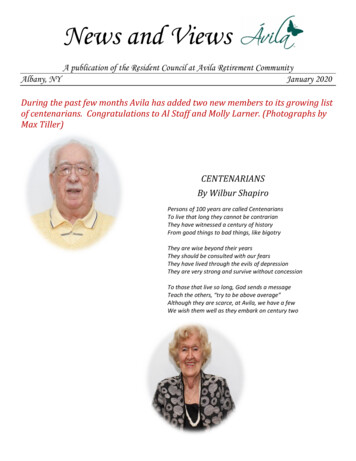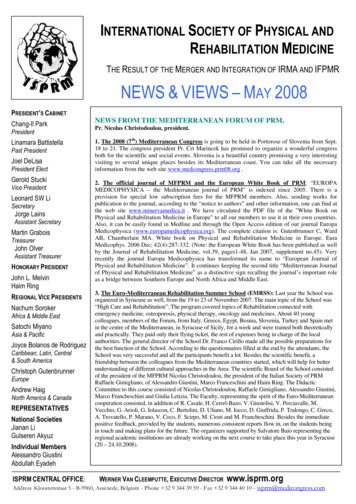
Transcription
News and ViewsA publication of the Resident Council at Avila Retirement CommunityAlbany, NYJanuary 2020During the past few months Avila has added two new members to its growing listof centenarians. Congratulations to Al Staff and Molly Larner. (Photographs byMax Tiller)CENTENARIANSBy Wilbur ShapiroPersons of 100 years are called CentenariansTo live that long they cannot be contrarianThey have witnessed a century of historyFrom good things to bad things, like bigotryThey are wise beyond their yearsThey should be consulted with our fearsThey have lived through the evils of depressionThey are very strong and survive without concessionTo those that live so long, God sends a messageTeach the others, “try to be above average”Although they are scarce, at Avila, we have a fewWe wish them well as they embark on century two
News and ViewsCHLOE AND ROD CORRELLPage 2January 2020Interviewed by Murray BlockRod and Chloe Correll are our very friendly and affable new neighbors in Apartment 148Lin the Lodge. They were born just one month apart, in different parts of New York City, Rod inManhattan and Chloe in Queens. They grew up near eachother on the north shore of Long Island, Chloe in Manhasset,and Rod in Great Neck. They were destined to meet and,thanks to Rod’s best friend, they did, on a blind date in 1951when both were sophomores, Chloe at Manhasset High andRod at Lawrenceville. They dated off and on during their highschool and college years, Rod at Yale, Chloe at Goucher, andfinally tied the knot in 1957, a strong bond that has lasted62 years.Directly after graduating from Yale in 1957, Rod joinedhis father at Hermann Loewenstein, Inc., the leather tanningand merchandising firm founded in NYC by his grandfather in1893. When its fortunes started to deteriorate in the mid-60s,Rod moved its headquarters and his family to upstate NewYork. The move proved fruitful; the reorganized company andPHOTOGRAPH BY MAX TILLERhis growing family started to flourish. Besides her primaryroles as mother and homemaker, Chloe’s talents as an artist played an important part in thecouple’s lives. The paintings on the walls of their apartment here at Avila attest to her skills.Less obvious is the importance of the part she played as the firm’s fashion director during thenine year stint following its departure from NYC. Her eye for color and her warmth as apresenter of its leathers were major factors in the firm’s resurgence. Equally important was thepart she played later as office manager of the Family Firm Institute, a networking organizationfor family business consultants that Rod helped found and led after he graduated with an MBAfrom the Yale School of Management in 1985.The couple has three children, one of whom, Douglas, died unexpectedly in 2016. Theiroldest, Catherine, is a nurse/midwife and works locally at St. Peters Hospital. Her husband FrankYunker is a professor at Fulton-Montgomery Community College. They live in nearby Niskayunaand have three daughters, Alex (25), Rebecca (23) and Emily (19). Their other son, Edward,lives in Long Beach on the south shore of Long Island. Edward is working as a schoolpsychologist and his wife Monica is a grade school teacher. They have two teenage sons,Thomas and Daniel.Chloe’s current interests are playing bridge, doing crossword puzzles and reading. Shekeeps herself fit here doing water aerobics. Rod’s exercise routine includes stints in the Lodge’sfitness room on the stationary bike and doing stretching, strengthening and balancing exercises.He is an avid Scrabble player, aspiring writer and, together with Chloe, enjoys playing bridge,doing crossword puzzles, attending opera, symphony and ballet performances.After 42 years in their large Victorian home in Johnstown, Rod and Chloe decided it wastime to move on. In 2013, after visiting a friend who lives in a retirement community nearBuffalo, they decided this sort of life might suit them. A six year search began, culminating inthe selection of Avila in the early months of 2019.
News and ViewsPage 3January 2020Their decision to come here was affected by several factors. First was their desire to locate nearone of their children. Second was the attractiveness of the Avila campus and the apartmentsbeing offered to them. Third was recommendations given by friends. And finally, there was thewarmth and compassionate nature of Geri Curtin, the first of many Avila staff members andresidents who have welcomed them prior to and since they moved here. That’s not surprising;they are a welcome addition to our warm and friendly community.JOANN AND TONY CRINIERIInterviewed by Wilbur ShapiroTony and JoAnn grew up in Newburgh, NY. Tony is agraduate of Albany State Teachers College (SUNY), earning abachelor’s and a master’s in business education. JoAnn is agraduate of the College of New Rochelle and majored ineducation. They married in 1964. Tony taught at CorningCommunity College until an opportunity arose in WestVirginia. Parkersburg Community College—later to becomepart of West Virginia University—wanted to set up a programin secretarial science. Tony accepted the position, andcourses were established in typing, business math,accounting, etc.While in West Virginia, JoAnn obtained a master’sdegree from West Virginia University. She taught English,religion, and Latin at Parkersburg Catholic High School andalso served as junior high guidance counselor. Tony taught at PHOTOGRAPH BY MAX TILLERWest Virginia University-Parkersburg and also served as Business Department chairman, beforeretiring as professor emeritus.After some 47 years in Vienna, West Virginia, the Crinieris packed up and entered Avila inSeptember 2019. They came here to be closer to their two children. Cathleen is assistantdirector of the intensive English language program at UAlbany. Michael is a managing directorat Goldman Sachs in New York City.After graduating from Albany State, Tony served in the Army and was stationed at WestPoint. The Crinieri family loves traveling in Canada and the United States. They have spentmany summers in Maine and in the Adirondacks. In addition, JoAnn has traveled to Ireland,France, Italy, Germany, Belgium, Japan, and Hong Kong.The Crinieris were very active in their community, including volunteering at a weekly soupkitchen and at St. Michael’s Parish. They both love reading, and JoAnn enjoys water exercise inthe Avila pool.The Crinieris are enjoying their lives at Avila, and Avila is very happy that they returned totheir roots and are making significant contributions to the Avila community.
News and ViewsBETSY MCCARTHYPage 4January 2020By Karl GohlkeAn Albany native, Betsy McCarthy has enjoyed alife full of family and friends, all of whom continue toreside in the Capital District. Many of her friends havemoved into Avila and have made her assimilation veryeasy.Betsy was raised on Holland Avenue and moved toa South Main Street residence upon her marriage to thelove of her life, Justin McCarthy. She related that he hadbecome the object of her romantic life when she wasonly 15 and continued to his sudden and untimely deathat age 50. A widow with five children, she was able tocontinue to manage her family with the support of herfriends and faith.Her family had established deep roots in thegreaterAlbany community. Her 5 children and 15PHOTOGRAPH BY KARL GOHLKEgrandchildren attended parochial schools and collegesand have been involved in business and government enterprises. Of some note, only five of herchildren and grandchildren are females. Males have dominated the family tree.Avila was not her first down-sized location. She had moved into another congregatecommunity where most of the residents were not retired but were out of the community most ofthe day. She was looking for a more communal residence and she says she has found it at Avila.Early success in the very competitive bingo arena and the reconnection with many of her oldfriends has convinced her that she is in the right place.BARBARA MULLERBy Maxine KoblenzOne of the special things about the Avila Newsand Views interviews are the great new people you getto meet, learn about and welcome into the Avilacommunity.Barbara or “Basha” (which means Barbara inPolish) is her nickname with family and friends. Shewas married for 56 years to her husband, an engineerwith the telephone company. She lived on Long Islandfor 14 years then moved to Guilderland for over 30years. Barbara has two sons and six beautiful,successful college-educated grandchildren.She graduated from college 20 years after highschool to become a physical therapy assistant for 22years in the Albany-Schenectady-Schoharie BOCESschool districts working with physically and mentallychallenged students.PHOTOGRAPH BY MAX TILLER
News and ViewsPage 5January 2020She loves reading and is a history buff stemming in part from her interest in theCivil War and WWII.Barbara enjoyed travel; liked Ireland and Austria best. She is also a proficient“distance cyclist,” biking as much as fifty 100 mile trips in New York, Rhode Island,Virginia, and South Carolina, as well as many other locations. She hopes to return tobiking in the spring.She was introduced to Avila through her daughter-in-law’s mother who was aresident here. Barbara describes Avila as friendly and “homey” and she can easily shareexperiences and interests with other residents. She has found many age appropriateactivities, good physical fitness opportunities and a great location; easy for her BallstonLake son to drive to and her Guilderland neighbors to visit.The challenging first few months of residency were eased by having her bestfriend, Bella Rose, her Lhasa Apso with her. Bella made Barbara’s difficult transition toAvila doable because of all the people who responded positively to her pet. Barbara isgrateful to Avila staff who installed a sidewalk outside her east rear door making life somuch easier for her and Bella Rose to exit.Her bucket list includes cycling around Cape Cod, a walk around Central Park andwalking across the Brooklyn Bridge. May all this come to fruition as we give a warmwelcome to “Basha.”MILLIE POLSIKBy Erin TeichmanMillie was born in Yonkers, NY, the youngest of 12.She has one sister remaining. She met her husband,Louis, at her sister’s wedding. They married in 1951.Millie worked for various businesses as a secretary whileLouis became a linotypist for a Hastings-on-Hudsonnewspaper.She has two children, Gary, who lives in SaratogaSprings, and Laura in Guilderland. Laura and her husbandJoseph are the parents of four sons, two of whom still livein the area. She also has three great-grandchildren, KatyLou, Toby, and Hudson.In 1958 the family moved to Schenectady for Louis’sjob on the Schenectady Gazette where he remained for 24years. After retiring from her job in the bursar’s office ofSUNY Albany, Millie and Louis travelled. They visited 26countries over the years. Millie’s favorites were Egypt andSwitzerland.Millie was widowed in 2018; continued to live in theirRotterdam condo until her children encouraged her tomove “somewhere safe,” so she chose Avila which is closePHOTOGRAPH BY MAX TILLERto Laura’s home. Thus far Millie is enjoying settling into her apartment and meeting herneighbors. Welcome to Avila, Millie!
News and ViewsSTEVE RINGSPage 6January 2020By John WagnerSteve Rings, a recent resident of the Lodge, hasrather deep Albany roots. His grandfather bought propertyin Guilderland, just beyond the Albany city limits. Hisparents built their house there when Steve's motherinherited the land on Church Road. Steve and his twosiblings grew up there.Steve went to Guilderland High School and then toAlfred University in western New York State where hemajored in history. Interested in teaching history, he wentto the University of Wisconsin in Milwaukee, seeking amaster's degree. When Steve recognized the scarcity ofpositions for high school history teachers, he returned toAlbany and enrolled in Albany Law School. With his lawdegree, Steve joined the New York State's Department ofInsurance. For over 20 years, he was involved in thereview of insurance policies to verify their compliance withPHOTOGRAPH BY MAX TILLERstate regulationsSteve has travelled in the United States and Europe. One of his more memorablewas a trip to the Netherlands. He was there for that country's tulip festival. As anAlbanian, he was quite proud of his city's tulip festival, but was awe-struck by thebeauty and size of the Dutch version.Another of his pleasures is cigar smoking. Now, he must enjoy them in the CigarLounge at the Premium Cigar Shop on Central Avenue. In addition to the chance toenjoy his delightful cigars, the Lounge is also the site of a book club to which hebelongs. Recently, the club was discussing The Topeka Road by Ben Lerner.His other hobbies include collecting things. Steve has an extensive coin collection,most of which now resides in a safe deposit box. He also likes movies from the classicsof the WWII era, with actors like Errol Flynn, John Wayne, and Clint Eastwood (in the"spaghetti westerns"). In the process of "down-sizing," Steve was forced to part withmuch of his library of books.For many years, Steve lived with his parents to assist them when his father's firmclosed its doors and then to help them as they aged. He is now very pleased to be hereat the Lodge with its warm family environment.
News and ViewsSR. MARIE LOUISE WOLFINGTONPage 7January 2020By Karl GohkleSister Marie Louise Wolfington returned tothe Albany area following a long journey of servicein the Society of the Sacred Heart. She hadentered the Society at the Kenwood Conventfollowing her graduation from ImmaculataCollege. She was 21.A native of Philadelphia, her life in servicewould take her to many locations in differentstates and different countries. She started out asan elementary school teacher in the Washingtonarea and moved into administration as sheprogressed through a series of assignments in awide range of locations ranging from Rhode IslandPHOTOGRAPH BY KARL GOHLKEand Massachusetts to Florida and Louisiana to anorthern section of India. An engaging individual, she was willing and able to take on new anddifficult assignments with a variety of communities, often during challenging times. She took onan assignment post-Katrina to work in building housing for high school and college studentsdisplaced following the hurricane. She often was assigned to take charge when a new challengepresented.Sister Marie Louise has become very interested in the environmental protectionmovement, the pollution prevention efforts, particularly the reduction in the use of plastics whichare not degradable. Her Society has committed itself to coastal restoration and healthy waters.Sister M-L, as she prefers to be addressed, has joined some of her friends and colleagueswhom she has known for years. She is integrating easily into the Avila community. She residesin the Lodge and may be reached at extension 791.A GOD GARDENSubmitted by Marion Kuritz (author unknown)In my god garden I would first plant four rows of peas; preparedness, promptness,preservation, and politeness.Next to them I would plant three rows of squash; squash gossip, squash criticism, andsquash indifference.Then I would put in four rows of lettuce; lettuce be unselfish, lettuce be loyal, lettuce loveone another, and lettuce be truthful.No garden is complete without turnips, and mine would have turnip with a smile, turnipwith a new idea, and turnip with real determination.
News and ViewsBY THE DEEP BLUE SEAPage 8January 2020By Don StaufferWhen you walk down the hall from the mailroom of the Grand Lodge you will see to yourright what appears to be an enchanted blue undersea grotto, but upon a second look it is aseaside scene, replete with waves, swimmers, and birds flying overhead. Also dotted here andthere are fishnets, life preservers and other paraphernalia of the sea.PHOTOGRAPH BY MAX TILLERPHOTOGRAPH BY MAX TILLERThis is the work of Barbara Howansky, Fitness Director, which came about, she says,during a conversation with Alton Mendleson, when they agreed that the entrance was ratherdrab and could use some fixing up. So she and three of her staff, Jeanette, Nicola and Mary, setto work to paint it blue. Then Barbara, who has some experience as a sign painter, fashionedpatterns for the waves, swimmers, etc. and hand painted them on the walls.The result has been a welcome freshening up for this much-used passageway. Thoughone resident did not care for the shade of blue and another worried about having to takeDramamine, the response has been overwhelmingly positive. One resident says that on a daywhen he is feeling down in the dumps he just has to walk in there to feel his spirits lifting.It’s still a work in progress at this writing, Barbara says. Still to be added are pictures ofall the staff members, and a motto over the exit: “Seas the day!”ZOROASTER TO CYRUS THE GREAT IN 596 BC Youth is not a time of life . . . it is a state of mind.Nobody grows old by merely living a number of years – people grow old by deserting theirideals.Years wrinkle the skin but giving up enthusiasm wrinkles the soul!Worry, doubt, self-distrust, fear and despair – these are the long years that bow the headand turn the growing spirit back to dust.
News and ViewsDEPRESSION IN OLDER PERSONSSubmitted by Jodi Mitchell-RosaPage 9January 2020The following article was taken from the NAMI, National Alliance on Mental Illness, Depression inOlder Persons Fact Sheet.According to NAMI, National Alliance on Mental Illness, Depression affects more than 6.5million of the 35 million Americans aged 65 or older. Most people in this stage of life withdepression have been experiencing episodes of the illness during much of their lives. Others mayexperience a first onset in late life—even in their 80s and 90s. Depression in older persons isclosely associated with dependency and disability and causes great distress for the individualand the family. Why does depression in the older population often go untreated? Depression inelderly people often goes untreated because many people think that depression is a normal partof aging—a natural reaction to chronic illness, loss and social transition. Many elderly people andtheir families don’t recognize the symptoms of depression, aren’t aware that it is a medicalillness and don’t know how it is treated.Others may mistake the symptoms of depression as signs of: dementia Alzheimer’s disease arthritis cancer heart disease Parkinson’s disease stroke thyroid disordersAlso, many older persons think that depression is a character flaw and are worried aboutbeing teased or humiliated. They may blame themselves for their illness and are too ashamed toget help. Others worry that treatment would be too costly. Yet research has also shown thattreatment is effective and, in fact, changes the brain when it works.What are the consequences of untreated depression in olderpersons? Late-life depression increases risk for medical illness andcognitive decline. Unrecognized and untreated depression has fatalconsequences in terms of both suicide and nonsuicide mortality:older Caucasian males have the highest rate of suicide in the U.S.Depression is the single most significant risk factor for suicide in theelderly population. Tragically, many of those people who go on to dieby suicide have reached out for help—20 percent see a doctor theday they die, 40 percent the week they die and 70 percent in themonth they die. Yet depression is frequently missed. Elderly personsare more likely to seek treatment for other physical ailments thanthey are to seek treatment for depressionFor some older people, particularly those with lifelong historiesof depression, the development of a disabling illness, loss of aspouse or a friend, retirement, moving out of the family home orsome other stressful event may bring about the onset of adepressive episode. It should also be noted that depression can be aside effect of some medications commonly prescribed to olderpersons, such as medications to treat hypertension. Finally, depression in the elderly populationcan be complicated and compounded by dependence on substances such as alcohol, which actsas a depressant.
News and ViewsPage 10January 2020Are some older persons at higher risk for depression? Older women are at a greater risk:women in general are twice as likely as men to become seriously depressed. Biological factors,like hormonal changes, may make older women more vulnerable. The stresses of maintainingrelationships or caring for an ill loved one and children also typically fall more heavily on women,which could contribute to higher rates of depression. Unmarried and widowed individuals as wellas those who lack a supportive social network also have elevated rates of depression. Conditionssuch as heart attack, stroke, hip fracture or macular degeneration and procedures such asbypass surgery are known to be associated with the development of depression. In general,depression should be assessed as a possibility if recovery from medical procedure is delayed,treatments are refused or problems with discharge are encountered.Can depression in older persons be treated? Fortunately, the treatment prognosis fordepression is good. Once diagnosed, 80 percent of clinically depressed individuals can beeffectively treated. Medications can be beneficial for elderly individuals in treating the symptomsof depression. Medications are frequently combined with supportive psychotherapy or cognitivebehavioral therapy to improve their effectiveness. Research has shown that depressedindividuals may need to try more than one medication to get an optimal response. Psychosocialtreatment plays an essential role in the care of older patients who have significant life crises,lack social support or lack coping skills to deal with their life situations. Because large numbersof elderly people live alone, have inadequate support systems or do not have contact with aprimary care physician, special efforts are needed to locate and identity these people to providethem with needed care. Natural supports like church or bridge group colleagues should beencouraged. There are services available to help older individuals, but the problem of clinicaldepression must be detected before treatment can begin. Like diabetes or arthritis, depression isa chronic disease. Getting well is only the beginning of the challenge—the goal is staying well.The treatment that gets someone well is the treatment that will keep that person well.If a resident is concerned about feelings of depression, please seek out assistance fromyour medical doctor, or see the resident service advisor for a list of mental health resources.ERA OF THE HUDSON RIVER STEAMBOATS - 1807 to 1948By Steve RotterThe era of the steamboat began in 1769 when a Scotsman named James Watt patentedan improved version of the steam engine that spurred other inventors on to explore thistechnology. This opened the door to the golden age of steamboats.In 1807, the first official trip of Robert Fulton’s “Clermont” went from New York City toAlbany, making history with a 150 mile trip in 28 hours and 45 minutes at an average speed ofabout five miles per hour. One stop was made at Clermont for wood fuel with an arrival inAlbany to the great amazement and curiosity of the public. This was the inauguration of the firststeamboat. The boat was a side paddle wheel boat with a wood fired steam engine. The next sixyears saw six steamers built for commercial travel on the Hudson River with five stops madefrom Newburgh to Albany. Fares ranged from 3 to 7. Time for the trips was 14 hours toNewburgh and 36 hours to Albany.
News and ViewsPage 11January 2020In 1855 the Hudson River Day Line wasstarted by two gentlemen who purchased thesteamboats “Daniel Drew” and “Armenia” and ranservice between Albany and New York every day—one trip south followed by one trip north the nextday. The “Daniel Drew” went into service in 1855and was considered the “Jewel of the Hudson,”setting speed records of 7 hours and 20 minutesfrom New York to Albany. She also had a steamcalliope that attracted a lot of people as it traveledalong the river. Ads were placed in 1863 for thesetwo ships to carry passengers from New York City for an unheard of price of 1.50.About 22,000people took advantage of this price which showed a nice profit for the company.The company was considered the premier steamboat line on the Hudson River from the1860’s through the 1940’s, carrying millions of passengers between New York City and Albany.In the 1800’s, without air conditioning, people living in tenements or homes in the cityfound reasons to escape the heat and overcrowding. One was a very special event, a memorableboat ride on a steamer on the Hudson River where they could feel any breeze that was comingoff the river and the mountains of the Hudson Valley. Passengers donned their Sunday best andstrolled along the deck to watch the paddle wheel go around and the banks of the river drift by.In most cases a straw hat was the standard attire, while sitting in a deck chair with a mint julipin handIn the second half of the nineteenth century,steamships resembled floating palaces and a ride on apaddle wheel steamer on the river was a pleasant andmemorable trip, even on the hottest day. There werelounges with writing tables, dining rooms, a men’s salonand a ladies salon, also a barber shop and a bar. Interiorswere fitted with velvet upholstered seating, crystalchandeliers, fine paintings and wall to wall carpeting. Onmany occasions an orchestra was provided for dancingand entertainment. Newsstands provided the latestnewspapers. On rainy days passengers could move inside or go to one of the highly appointeddining rooms for lunch or dinner.Major vacation destinations were the Catskill Mountain region, Bear Mountain State Park,Kingston Point Park and West Point Military Academy. These were great stopovers for hiking,walking or a nice picnic along the river.The Hudson River Day Line was incorporated in 1899 and was in existence until 1948. In1892 the Day Line transported 192,000 passengers. That number increased to 266,000 in 1902with a large jump to 2 million in 1925.A total of 16 steamers were part of the company fleet from 1887 to 1927. All ships wereside-paddle steamers except the “Peter Stuyvesant” which was the only prop driven ship on theline. This ship was built in 1927 and was the last great boat for the Hudson River Day Line.In 1912 the steamer “Washington Irving” was built as the largest and grandest of all shipsof the Hudson River Day Line. She was 416 feet long and could accommodate 6,000 people onfive decks, had a dance floor and bandstand for popular moonlight dances and could also travelat 23 mph.By the 1930’s, a three-hour air conditioned train trip to New York City would allow up toten hours in the city for business or entertainment and a three hour return trip, all in one day.Paddle wheel steamboats would now be only wonderful memories. Trains would no longer be adusty dirty way to travel.
News and ViewsPage 12January 2020In 1948 the steamer “Robert Fulton” made the last run of the Day Line. What RobertFulton started in 1807, his namesake steamer ended in 1948. In September of 1971, a survivorof the Day Line, the Alexander Hamilton, finished the glorious run of the steamboat on theHudson River.Sources: Albany Gazette of 1807; New York State Library; Thought Company; Early Years ofSteam boating by Peter Hess ; Hudson River Maritime Museum; Albany Institute of Art ;TheMuseum on Blue Mountain Lake.WHAT IFBy Rod CorrellI am the son of the son of a German Jew, turned Ethicist, who immigrated to the UnitedStates in 1893 and founded a leather import-export business in New York City. HermannLoewenstein was one of 13 children in a family living in Ellwangen, a small city near Stuttgart.His father was a lawyer and most of his male siblings were destined to become professionals.Hermann was headed down this path, matriculating at Oxford with plans to become a professor.Illness in early adulthood changed that trajectory; becoming nearly blind as he began his studiesat university his life changed dramatically. With his dream dismantled, his family sought help.Relatives who owned a tannery in Ulm offered him a job and Hermann sailed to America to setup an office in New York. It turned out to be a good decision; the business flourished but I oftenwonder whether my granpere ever had regrets.My father’s dream of becoming an architect was also blocked, presumably because hisgrades in prep school were rather poor and his father felt that a career in the leather businesswould suit him better. Once again the decision, made for not by him proved to be the right one.Dad was a great salesman with a keen sense for fashion trends, a combination of skills that gavehim pride and made the firm even more profitable during most of his leadership. Once again,however, I wonder whether he felt at peace with this decision and his role as successor of alegendary founder.And how about my dream to become a teacher after Igraduated from Yale? By then imports from Italy and Spain hadstarted to flood into our market threatening the viability of ourmajor customer base, manufacturers of high-grade ladies fashionfootwear. There was also a problem on the supply side;consumption of veal in the U.S. was declining, the supply ofcalfskins was dropping and their price was rising. The handwritingwas on the wall; our salad days were over. Despite thesewarnings my dad insisted I follow him into the firm. “Teachers arewimps” he told me and that was that. Succumbing to his will paidoff handsomely but to this day I wonder why he was so insistentand what might have happened if I had had the guts to say no.There are lessons to be learned from what I experienced, tales I hope I can tell in anengaging way in the memoir I plan to
graduate of Albany State Teachers College (SUNY), earning a bachelor's and a master's in business education. JoAnn is a graduate of the College of New Rochelle and majored in education. They married in 1964. Tony taught at Corning Community College until an opportunity arose in West Virginia. Parkersburg Community College—later to become










